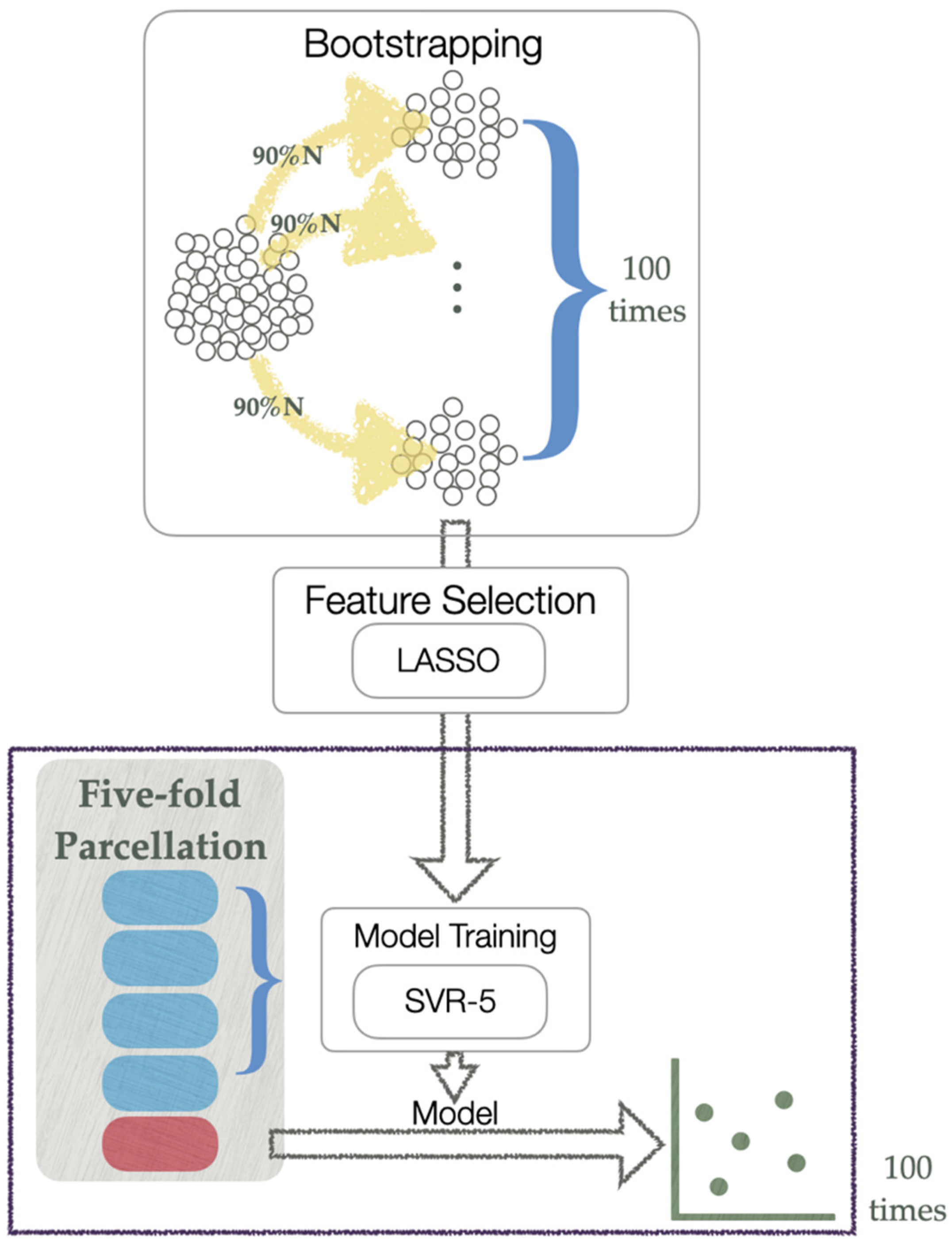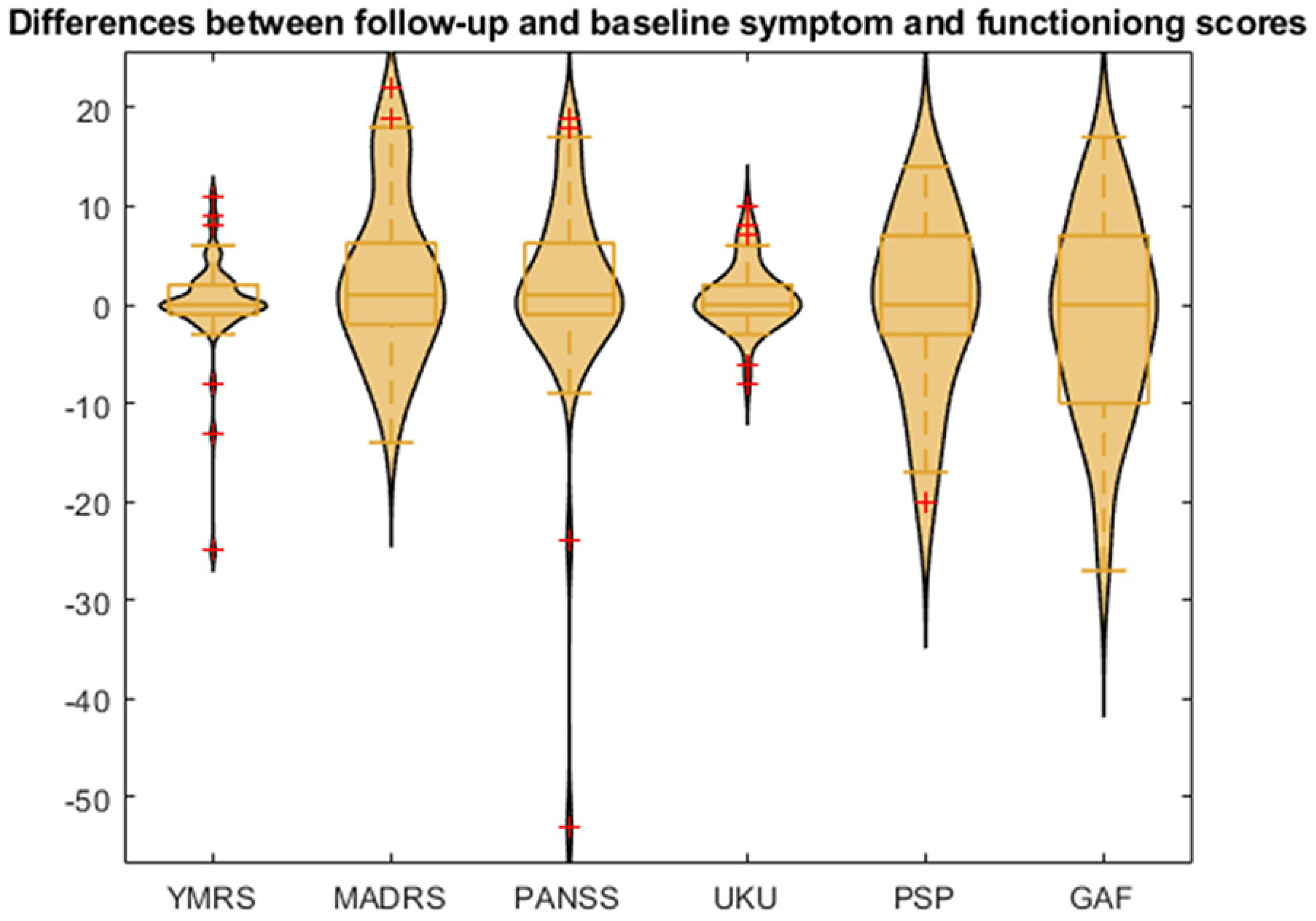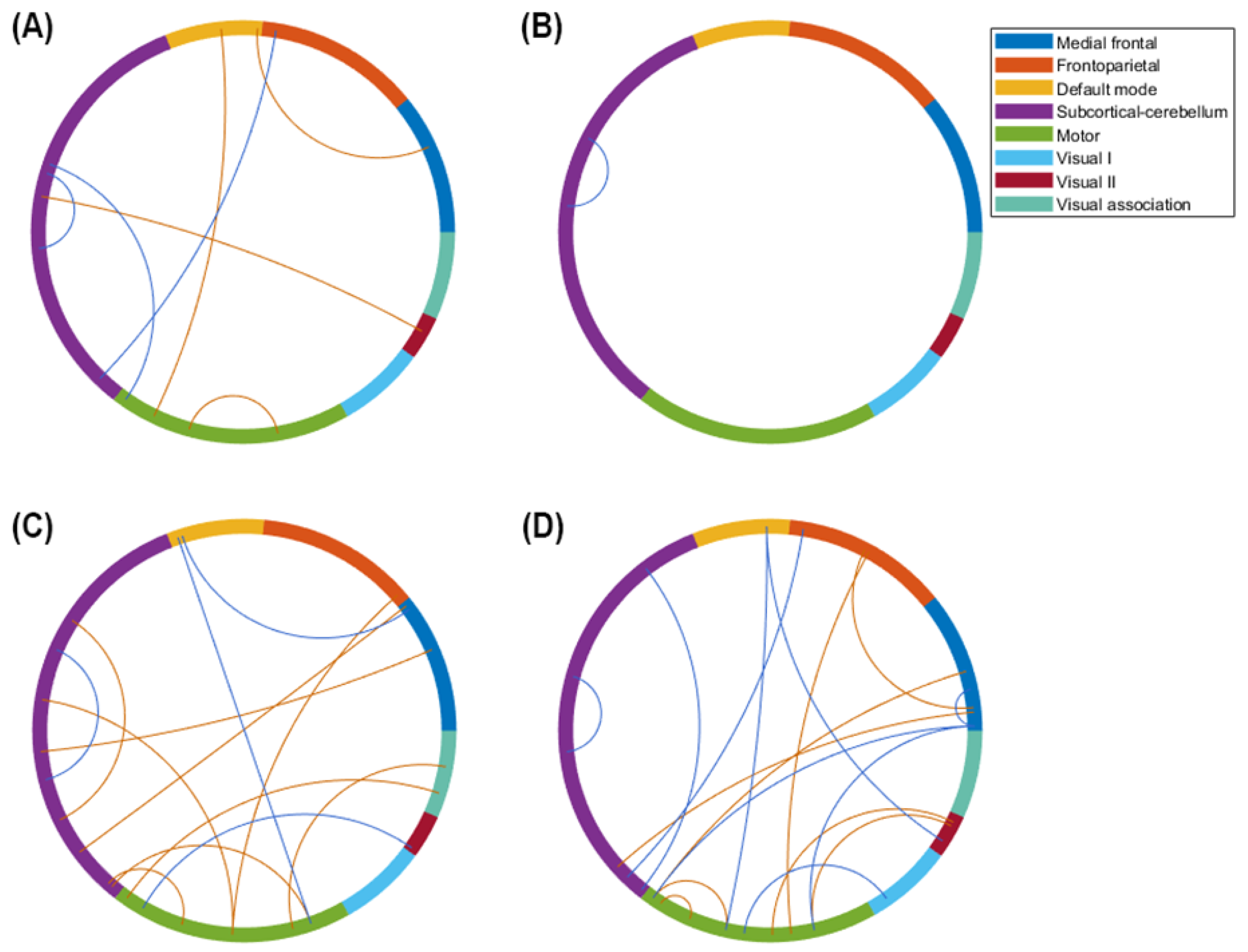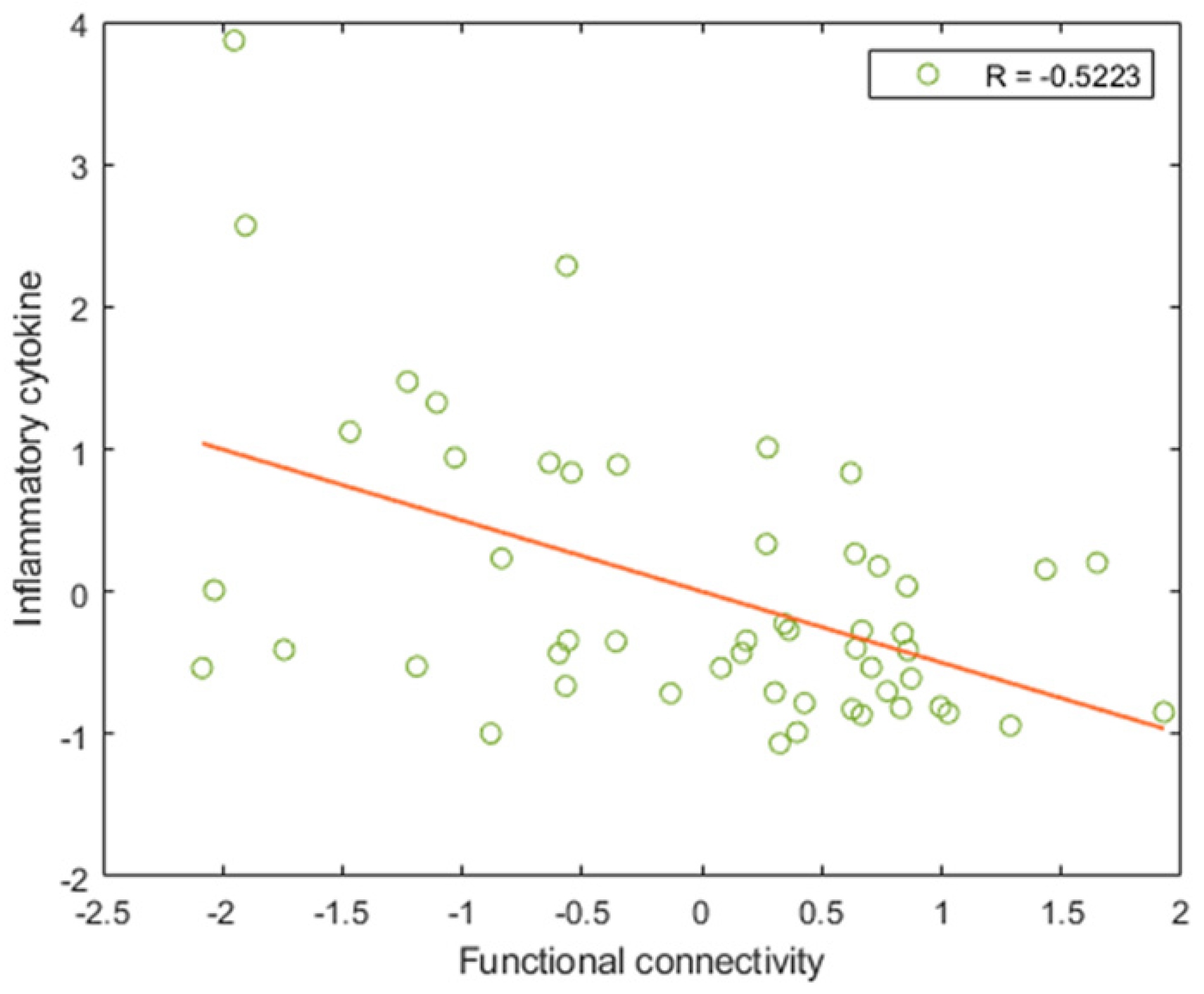Neurobiological Markers for Predicting Treatment Response in Patients with Bipolar Disorder
Abstract
1. Introduction
2. Materials and Methods
2.1. Participants
2.2. Acquisition of Resting-State Functional and Structural Magnetic Resonance Imaging Images and Inflammatory Biomarkers
2.3. Preprocessing for Resting-State Functional and Structural MRI Data
2.4. Feature Extraction
2.5. Feature Selection and Model Training for Predicting the Differences between the Follow-Up and Initial Symptom and Functioning Scores
2.6. Effects of Confounding Variables on the Prediction
3. Results
3.1. Prediction Model Performance for the Changes in Symptom and Functioning Scores of the Patients
3.2. Features Selected for the Models Developed for Predicting the Changes in Symptom and Functioning Scores
3.3. Potential Influence of Various Clinical Confounding Factors on the Regression Performance of the Changes in Symptom and Functioning Scores
3.4. Relationship between Major Features and Inflammatory Markers
4. Discussion
Author Contributions
Funding
Institutional Review Board Statement
Informed Consent Statement
Data Availability Statement
Acknowledgments
Conflicts of Interest
References
- Pinto, J.V.; Saraf, G.; Kozicky, J.; Beaulieu, S.; Sharma, V.; Parikh, S.V.; Cervantes, P.; Daigneault, A.; Walji, N.; Kauer-Sant’Anna, M.; et al. Remission and Recurrence in Bipolar Disorder: The Data from Health Outcomes and Patient Evaluations in Bipolar Disorder (HOPE-BD) Study. J. Affect. Disord. 2020, 268, 150–157. [Google Scholar] [CrossRef] [PubMed]
- Grande, I.; Berk, M.; Birmaher, B.; Vieta, E. Bipolar Disorder. Lancet 2016, 387, 1561–1572. [Google Scholar] [CrossRef] [PubMed]
- Goodwin, F.K.; Jamison, K.R. Manic-Depressive Illness: Bipolar Disorders and Recurrent Depression, 2nd ed.; Oxford University Press: Oxford, NY, USA, 2007; ISBN 978-0-19-513579-4. [Google Scholar]
- Schneider, M.R.; DelBello, M.P.; McNamara, R.K.; Strakowski, S.M.; Adler, C.M. Neuroprogression in Bipolar Disorder. Bipolar Disord. 2012, 14, 356–374. [Google Scholar] [CrossRef] [PubMed]
- Kapczinski, N.S.; Mwangi, B.; Cassidy, R.M.; Librenza-Garcia, D.; Bermudez, M.B.; Kauer-Sant’anna, M.; Kapczinski, F.; Passos, I.C. Neuroprogression and Illness Trajectories in Bipolar Disorder. Expert Rev. Neurother. 2017, 17, 277–285. [Google Scholar] [CrossRef]
- López-Jaramillo, C.; Lopera-Vásquez, J.; Gallo, A.; Ospina-Duque, J.; Bell, V.; Torrent, C.; Martínez-Arán, A.; Vieta, E. Effects of Recurrence on the Cognitive Performance of Patients with Bipolar I Disorder: Implications for Relapse Prevention and Treatment Adherence. Bipolar Disord. 2010, 12, 557–567. [Google Scholar] [CrossRef]
- Elshahawi, H.H.; Essawi, H.; Rabie, M.A.; Mansour, M.; Beshry, Z.A.; Mansour, A.N. Cognitive Functions among Euthymic Bipolar I Patients after a Single Manic Episode versus Recurrent Episodes. J. Affect. Disord. 2011, 130, 180–191. [Google Scholar] [CrossRef]
- Jiménez-López, E.; Sánchez-Morla, E.M.; López-Villarreal, A.; Aparicio, A.I.; Martínez-Vizcaíno, V.; Vieta, E.; Rodriguez-Jimenez, R.; Santos, J.L. Neurocognition and Functional Outcome in Patients with Psychotic, Non-Psychotic Bipolar I Disorder, and Schizophrenia. A Five-Year Follow-Up. Eur. Psychiatry 2019, 56, 60–68. [Google Scholar] [CrossRef]
- Tatay-Manteiga, A.; Cauli, O.; Tabarés-Seisdedos, R.; Michalak, E.E.; Kapczinski, F.; Balanzá-Martínez, V. Subjective Neurocognition and Quality of Life in Patients with Bipolar Disorder and Siblings. J. Affect. Disord. 2019, 245, 283–288. [Google Scholar] [CrossRef]
- Bearden, C.E.; Hoffman, K.M.; Cannon, T.D. The Neuropsychology and Neuroanatomy of Bipolar Affective Disorder: A Critical Review. Bipolar Disord. 2001, 3, 106–150. [Google Scholar] [CrossRef]
- Townsend, J.; Altshuler, L.L. Emotion Processing and Regulation in Bipolar Disorder: A Review. Bipolar Disord. 2012, 14, 326–339. [Google Scholar] [CrossRef]
- Wegbreit, E.; Ellis, J.A.; Nandam, A.; Fitzgerald, J.M.; Passarotti, A.M.; Pavuluri, M.N.; Stevens, M.C. Amygdala Functional Connectivity Predicts Pharmacotherapy Outcome in Pediatric Bipolar Disorder. Brain Connect 2011, 1, 411–422. [Google Scholar] [CrossRef] [PubMed]
- Bollettini, I.; Poletti, S.; Locatelli, C.; Vai, B.; Smeraldi, E.; Colombo, C.; Benedetti, F. Disruption of White Matter Integrity Marks Poor Antidepressant Response in Bipolar Disorder. J. Affect. Disord. 2015, 174, 233–240. [Google Scholar] [CrossRef] [PubMed]
- Kafantaris, V.; Spritzer, L.; Doshi, V.; Saito, E.; Szeszko, P.R. Changes in White Matter Microstructure Predict Lithium Response in Adolescents with Bipolar Disorder. Bipolar Disord. 2017, 19, 587–594. [Google Scholar] [CrossRef] [PubMed]
- Dusi, N.; De Carlo, V.; Delvecchio, G.; Bellani, M.; Soares, J.C.; Brambilla, P. MRI Features of Clinical Outcome in Bipolar Disorder: A Selected Review: Special Section on “Translational and Neuroscience Studies in Affective Disorders”. Section Editor, Maria Nobile MD, PhD. This Section of JAD Focuses on the Relevance of Translational and Neuroscience Studies in Providing a Better Understanding of the Neural Basis of Affective Disorders. The Main Aim Is to Briefly Summaries Relevant Research Findings in Clinical Neuroscience with Particular Regards to Specific Innovative Topics in Mood and Anxiety Disorders. J. Affect. Disord. 2019, 243, 559–563. [Google Scholar] [CrossRef]
- Sartori, J.M.; Reckziegel, R.; Passos, I.C.; Czepielewski, L.S.; Fijtman, A.; Sodré, L.A.; Massuda, R.; Goi, P.D.; Vianna-Sulzbach, M.; de Azevedo Cardoso, T.; et al. Volumetric Brain Magnetic Resonance Imaging Predicts Functioning in Bipolar Disorder: A Machine Learning Approach. J. Psychiatr. Res. 2018, 103, 237–243. [Google Scholar] [CrossRef]
- Fleck, D.E.; Ernest, N.; Adler, C.M.; Cohen, K.; Eliassen, J.C.; Norris, M.; Komoroski, R.A.; Chu, W.-J.; Welge, J.A.; Blom, T.J.; et al. Prediction of Lithium Response in First-Episode Mania Using the LITHium Intelligent Agent (LITHIA): Pilot Data and Proof-of-Concept. Bipolar Disord. 2017, 19, 259–272. [Google Scholar] [CrossRef]
- Wang, D.; Li, M.; Wang, M.; Schoeppe, F.; Ren, J.; Chen, H.; Öngür, D.; Brady, R.O.; Baker, J.T.; Liu, H. Individual-Specific Functional Connectivity Markers Track Dimensional and Categorical Features of Psychotic Illness. Mol. Psychiatry 2020, 25, 2119–2129. [Google Scholar] [CrossRef]
- Modabbernia, A.; Taslimi, S.; Brietzke, E.; Ashrafi, M. Cytokine Alterations in Bipolar Disorder: A Meta-Analysis of 30 Studies. Biol. Psychiatry 2013, 74, 15–25. [Google Scholar] [CrossRef]
- Munkholm, K.; Vinberg, M.; Vedel Kessing, L. Cytokines in Bipolar Disorder: A Systematic Review and Meta-Analysis. J. Affect. Disord. 2013, 144, 16–27. [Google Scholar] [CrossRef]
- Van den Ameele, S.; van Diermen, L.; Staels, W.; Coppens, V.; Dumont, G.; Sabbe, B.; Morrens, M. The Effect of Mood-Stabilizing Drugs on Cytokine Levels in Bipolar Disorder: A Systematic Review. J. Affect. Disord. 2016, 203, 364–373. [Google Scholar] [CrossRef]
- Rosenblat, J.D.; McIntyre, R.S. Bipolar Disorder and Immune Dysfunction: Epidemiological Findings, Proposed Pathophysiology and Clinical Implications. Brain Sci. 2017, 7, 144. [Google Scholar] [CrossRef] [PubMed]
- Berk, M.; Kapczinski, F.; Andreazza, A.C.; Dean, O.M.; Giorlando, F.; Maes, M.; Yücel, M.; Gama, C.S.; Dodd, S.; Dean, B.; et al. Pathways Underlying Neuroprogression in Bipolar Disorder: Focus on Inflammation, Oxidative Stress and Neurotrophic Factors. Neurosci. Biobehav. Rev. 2011, 35, 804–817. [Google Scholar] [CrossRef] [PubMed]
- Goldsmith, D.R.; Rapaport, M.H.; Miller, B.J. A Meta-Analysis of Blood Cytokine Network Alterations in Psychiatric Patients: Comparisons between Schizophrenia, Bipolar Disorder and Depression. Mol. Psychiatry 2016, 21, 1696–1709. [Google Scholar] [CrossRef] [PubMed]
- Boufidou, F.; Nikolaou, C.; Alevizos, B.; Liappas, I.A.; Christodoulou, G.N. Cytokine Production in Bipolar Affective Disorder Patients under Lithium Treatment. J. Affect. Disord. 2004, 82, 309–313. [Google Scholar] [CrossRef] [PubMed]
- Guloksuz, S.; Altinbas, K.; Aktas Cetin, E.; Kenis, G.; Bilgic Gazioglu, S.; Deniz, G.; Oral, E.T.; van Os, J. Evidence for an Association between Tumor Necrosis Factor-Alpha Levels and Lithium Response. J. Affect. Disord. 2012, 143, 148–152. [Google Scholar] [CrossRef]
- Hastie, T.; Tibshirani, R.; Friedman, J. The Elements of Statistical Learning: Data Mining, Inference, and Prediction, 2nd ed.; Springer Science & Business Media: Berlin/Heidelberg, Germany, 2009; ISBN 978-0-387-84858-7. [Google Scholar]
- Isensee, F.; Schell, M.; Pflueger, I.; Brugnara, G.; Bonekamp, D.; Neuberger, U.; Wick, A.; Schlemmer, H.-P.; Heiland, S.; Wick, W.; et al. Automated Brain Extraction of Multisequence MRI Using Artificial Neural Networks. Hum. Brain Mapp. 2019, 40, 4952–4964. [Google Scholar] [CrossRef]
- Phillips, M.L.; Swartz, H.A. A Critical Appraisal of Neuroimaging Studies of Bipolar Disorder: Toward a New Conceptualization of Underlying Neural Circuitry and a Road Map for Future Research. AJP 2014, 171, 829–843. [Google Scholar] [CrossRef]
- Chen, C.-H.; Suckling, J.; Lennox, B.R.; Ooi, C.; Bullmore, E.T. A Quantitative Meta-Analysis of FMRI Studies in Bipolar Disorder. Bipolar Disord. 2011, 13, 1–15. [Google Scholar] [CrossRef]
- Jiang, X.; Dai, X.; Kale Edmiston, E.; Zhou, Q.; Xu, K.; Zhou, Y.; Wu, F.; Kong, L.; Wei, S.; Zhou, Y.; et al. Alteration of Cortico-Limbic-Striatal Neural System in Major Depressive Disorder and Bipolar Disorder. J. Affect. Disord. 2017, 221, 297–303. [Google Scholar] [CrossRef]
- Perry, A.; Roberts, G.; Mitchell, P.B.; Breakspear, M. Connectomics of Bipolar Disorder: A Critical Review, and Evidence for Dynamic Instabilities within Interoceptive Networks. Mol. Psychiatry 2019, 24, 1296–1318. [Google Scholar] [CrossRef]
- Baldaçara, L.; Nery-Fernandes, F.; Rocha, M.; Quarantini, L.C.; Rocha, G.G.L.; Guimarães, J.L.; Araújo, C.; Oliveira, I.; Miranda-Scippa, A.; Jackowski, A. Is Cerebellar Volume Related to Bipolar Disorder? J. Affect. Disord. 2011, 135, 305–309. [Google Scholar] [CrossRef] [PubMed]
- Shinn, A.K.; Roh, Y.S.; Ravichandran, C.T.; Baker, J.T.; Öngür, D.; Cohen, B.M. Aberrant Cerebellar Connectivity in Bipolar Disorder with Psychosis. Biol. Psychiatry Cogn. Neurosci. Neuroimaging 2017, 2, 438–448. [Google Scholar] [CrossRef] [PubMed]
- Wang, Y.; Zhong, S.; Chen, G.; Liu, T.; Zhao, L.; Sun, Y.; Jia, Y.; Huang, L. Altered Cerebellar Functional Connectivity in Remitted Bipolar Disorder: A Resting-State Functional Magnetic Resonance Imaging Study. Aust. N. Z. J. Psychiatry 2018, 52, 962–971. [Google Scholar] [CrossRef] [PubMed]
- Shakiba, A. The Role of the Cerebellum in Neurobiology of Psychiatric Disorders. Neurol. Clin. 2014, 32, 1105–1115. [Google Scholar] [CrossRef]
- Adamaszek, M.; D’Agata, F.; Ferrucci, R.; Habas, C.; Keulen, S.; Kirkby, K.C.; Leggio, M.; Mariën, P.; Molinari, M.; Moulton, E.; et al. Consensus Paper: Cerebellum and Emotion. Cerebellum 2017, 16, 552–576. [Google Scholar] [CrossRef] [PubMed]
- Johnson, C.P.; Christensen, G.E.; Fiedorowicz, J.G.; Mani, M.; Shaffer, J.J., Jr.; Magnotta, V.A.; Wemmie, J.A. Alterations of the Cerebellum and Basal Ganglia in Bipolar Disorder Mood States Detected by Quantitative T1ρ Mapping. Bipolar Disord. 2018, 20, 381–390. [Google Scholar] [CrossRef]
- Smucny, J.; Lesh, T.A.; Carter, C.S. Baseline Frontoparietal Task-Related BOLD Activity as a Predictor of Improvement in Clinical Symptoms at 1-Year Follow-Up in Recent-Onset Psychosis. AJP 2019, 176, 839–845. [Google Scholar] [CrossRef]
- Moore, P.B.; Shepherd, D.J.; Eccleston, D.; Macmillan, I.C.; Goswami, U.; McAllister, V.L.; Ferrier, I.N. Cerebral White Matter Lesions in Bipolar Affective Disorder: Relationship to Outcome. Br. J. Psychiatry 2001, 178, 172–176. [Google Scholar] [CrossRef]
- Estudillo-Guerra, M.A.; Pacheco-Barrios, K.; Cardenas-Rojas, A.; Adame-Ocampo, G.; Camprodon, J.A.; Morales-Quezada, L.; Gutiérrez-Mora, D.; Flores-Ramos, M. Brain Perfusion during Manic Episode and at 6-Month Follow-up Period in Bipolar Disorder Patients: Correlation with Cognitive Functions. Brain Behav. 2020, 10, e01615. [Google Scholar] [CrossRef]
- Insel, T.; Cuthbert, B.; Garvey, M.; Heinssen, R.; Pine, D.S.; Quinn, K.; Sanislow, C.; Wang, P. Research Domain Criteria (RDoC): Toward a New Classification Framework for Research on Mental Disorders. Am. J. Psychiatry 2010, 167, 748–751. [Google Scholar] [CrossRef]
- Kebets, V.; Holmes, A.J.; Orban, C.; Tang, S.; Li, J.; Sun, N.; Kong, R.; Poldrack, R.A.; Yeo, B.T.T. Somatosensory-Motor Dysconnectivity Spans Multiple Transdiagnostic Dimensions of Psychopathology. Biol. Psychiatry 2019, 86, 779–791. [Google Scholar] [CrossRef] [PubMed]
- Conio, B.; Martino, M.; Magioncalda, P.; Escelsior, A.; Inglese, M.; Amore, M.; Northoff, G. Opposite Effects of Dopamine and Serotonin on Resting-State Networks: Review and Implications for Psychiatric Disorders. Mol. Psychiatry 2020, 25, 82–93. [Google Scholar] [CrossRef] [PubMed]
- Felger, J.C.; Li, Z.; Haroon, E.; Woolwine, B.J.; Jung, M.Y.; Hu, X.; Miller, A.H. Inflammation Is Associated with Decreased Functional Connectivity within Corticostriatal Reward Circuitry in Depression. Mol. Psychiatry 2016, 21, 1358–1365. [Google Scholar] [CrossRef] [PubMed]
- Mehta, N.D.; Haroon, E.; Xu, X.; Woolwine, B.J.; Li, Z.; Felger, J.C. Inflammation Negatively Correlates with Amygdala-Ventromedial Prefrontal Functional Connectivity in Association with Anxiety in Patients with Depression: Preliminary Results. Brain Behav. Immun. 2018, 73, 725–730. [Google Scholar] [CrossRef]
- Fernandes, B.S.; Steiner, J.; Molendijk, M.L.; Dodd, S.; Nardin, P.; Gonçalves, C.-A.; Jacka, F.; Köhler, C.A.; Karmakar, C.; Carvalho, A.F.; et al. C-Reactive Protein Concentrations across the Mood Spectrum in Bipolar Disorder: A Systematic Review and Meta-Analysis. Lancet Psychiatry 2016, 3, 1147–1156. [Google Scholar] [CrossRef]
- Hickman, R.J.; Khambaty, T.; Stewart, J.C. C-Reactive Protein Is Elevated in Atypical but Not Nonatypical Depression: Data from the National Health and Nutrition Examination Survey (NHANES) 1999–2004. J. Behav. Med. 2014, 37, 621–629. [Google Scholar] [CrossRef]
- Milaneschi, Y.; Lamers, F.; Bot, M.; Drent, M.L.; Penninx, B.W.J.H. Leptin Dysregulation Is Specifically Associated With Major Depression With Atypical Features: Evidence for a Mechanism Connecting Obesity and Depression. Biol. Psychiatry 2017, 81, 807–814. [Google Scholar] [CrossRef]
- Mwangi, B.; Matthews, K.; Steele, J.D. Prediction of Illness Severity in Patients with Major Depression Using Structural MR Brain Scans. J. Magn. Reson. Imaging 2012, 35, 64–71. [Google Scholar] [CrossRef]




| Baseline (Mean ± SD) | Follow-Up (Mean ± SD) | Change from Baseline (Mean ± SD) | p-Value ‡ | |
|---|---|---|---|---|
| Age | 41.06 ± 11.733 | |||
| Duration of illness | 12.09 ± 9.185 | |||
| Sex | ||||
| Male (%) | 13 (24.5) | |||
| Female (%) | 40 (75.5) | |||
| Diagnostic subtype | ||||
| Type I | 31 (58.5) | |||
| Type II | 22 (41.5) | |||
| Medication † | ||||
| Atypical antipsychotics (%) | 35 (72.9) | |||
| Antidepressants (%) | 22 (45.8) | |||
| Mood stabilizers (%) | 37 (77.1) | |||
| Clinical assessment | ||||
| YMRS | 2.91 ± 4.861 | 3.08 ± 4.636 | 0.17 ± 5.049 | 0.8075 |
| MADRS | 9.64 ± 10.273 | 12.47 ± 10.789 | 2.83 ± 8.485 | 0.0187 |
| PANSS | 38.89 ± 11.265 | 40.43 ± 10.445 | 1.55 ± 10.745 | 0.2993 |
| UKU | 3.57 ± 3.208 | 4.42 ± 3.915 | 0.85 ± 3.319 | 0.0682 |
| PSP | 71.57 ± 10.231 | 71.42 ± 9.844 | −0.15 ± 8.880 | 0.9020 |
| GAF | 71.75 ± 10.963 | 70.40 ± 11.394 | −1.36 ± 9.909 | 0.3229 |
| Assessments | Mean ± SD of R † | Mean ± SD of R † after Removing Strong Outliers | R-Squared |
|---|---|---|---|
| YMRS | 0.6850 ± 0.1207 | 0.9187 ± 0.0867 | 0.8440 |
| MADRS | 0.8662 ± 0.0867 | 0.7503 | |
| PANSS | 0.6166 ± 0.0714 | 0.8887 ± 0.0784 | 0.7898 |
| UKU | 0.8861 ± 0.0649 | 0.7852 | |
| PSP | 0.8533 ± 0.0971 | 0.7281 | |
| GAF | 0.8595 ± 0.0770 | 0.7387 |
| Regions 1 (with Region Label) | Regions 2 (with Region Label) | |||||||
|---|---|---|---|---|---|---|---|---|
| YMRS | ||||||||
| 67 | Right fusiform gyrus | in | VA | – | 24 | Right supplementary motor area | in | MON |
| 76 | Right lingual gyrus | in | VisII | – | 33 | Right precentral cortex | in | MON |
| 158 | Left postcentral cortex | in | MON | – | 4 | Right superior orbitofrontal cortex | in | FPN |
| 158 | Left postcentral cortex | in | MON | – | 135 | Left inferior orbitofrontal cortex | in | SC |
| 179 | Left postcentral cortex | in | MON | – | 177 | Left superior parietal cortex | in | VA |
| 224 | Left middle cingular cortex | in | SC | – | 153 | Left inferior orbitofrontal cortex | in | MFN |
| 225 | Left precuneus | in | DMN | – | 194 | Left inferior temporal cortex | in | MFN |
| 227 | Left posterior cingular cortex | in | DMN | – | 189 | Left middle temporal pole | in | MON |
| 233 | Left parahippocampus | in | SC | – | 123 | Right caudate | in | SC |
| 249 | Left lobule VIII of cerebellum | in | SC | – | 114 | Right lobule VI of cerebellum | in | SC |
| 257 | Left caudate | in | SC | – | 219 | Left anterior cingular cortex | in | MFN |
| 266 | Left medulla | in | SC | – | 51 | Left middle temporal pole | in | MON |
| 267 | Left pons | in | SC | – | 189 | Left middle temporal pole | in | MON |
| MADRS | ||||||||
| 90 | Right precuneus | in | DMN | – | 37 | Right insula | in | MON |
| 126 | Right thalamus | in | SC | – | 24 | Right supplementary motor area | in | MON |
| 156 | Left inferior triangular frontal cortex | in | MFN | – | 3 | Right rectus | in | DMN |
| 172 | Left postcentral cortex | in | MON | – | 60 | Right inferior temporal cortex | in | MON |
| 212 | Left superior occipital cortex | in | VisII | – | 133 | Right pons | in | SC |
| 221 | Left anterior cingular cortex | in | SC | – | 128 | Right thalamus | in | SC |
| 264 | Left thalamus | in | SC | – | 242 | Left crus II of cerebellum | in | FPN |
| PANSS | ||||||||
| 24 | Right supplementary motor area | in | MON | – | 10 | Right superior medial frontal cortex | in | MFN |
| 39 | Right postcentral cortex | in | MON | – | 26 | Right superior frontal cortex | in | MON |
| 62 | Right Heschl’s gyrus | in | MON | – | 24 | Right supplementary motor area | in | MON |
| 62 | Right Heschl’s gyrus | in | MON | – | 49 | Right angular gyrus | in | DMN |
| 64 | Right middle temporal cortex | in | MFN | – | 10 | Right superior medial frontal cortex | in | MFN |
| 81 | Right inferior occipital cortex | in | VisII | – | 49 | Right angular gyrus | in | DMN |
| 92 | Right amygdala | in | MON | – | 75 | Right superior occipital cortex | in | VisI |
| 112 | Right lobule VIII of cerebellum | in | FPN | – | 53 | Right middle temporal pole | in | MFN |
| 145 | Left superior medial frontal cortex | in | MFN | – | 24 | Right supplementary motor area | in | MON |
| 168 | Left insula | in | MON | – | 111 | Right crus II of cerebellum | in | FPN |
| 174 | Left paracentral lobule | in | MON | – | 10 | Right superior medial frontal cortex | in | MFN |
| 213 | Left lingual gyrus | in | VisII | – | 174 | Left paracentral lobule | in | MON |
| 214 | Left infeior occipital cortex | in | VisII | – | 161 | Left supplementary motor area | in | MON |
| 224 | Left middle cingular cortex | in | SC | – | 129 | Right medulla | in | SC |
| 261 | Left putamen | in | SC | – | 52 | Right middle temporal pole | in | MFN |
| 264 | Left thalamus | in | SC | – | 242 | Left crus II of cerebellum | in | FPN |
| 268 | Left pons | in | SC | – | 88 | Right middle cingular cortex | in | SC |
| UKU | ||||||||
| 136 | Left rectus | in | SC | – | 120 | Right caudate | in | SC |
Publisher’s Note: MDPI stays neutral with regard to jurisdictional claims in published maps and institutional affiliations. |
© 2022 by the authors. Licensee MDPI, Basel, Switzerland. This article is an open access article distributed under the terms and conditions of the Creative Commons Attribution (CC BY) license (https://creativecommons.org/licenses/by/4.0/).
Share and Cite
Chen, Y.-L.; Huang, T.-H.; Tu, P.-C.; Bai, Y.-M.; Su, T.-P.; Chen, M.-H.; Hong, J.-S.; Wu, Y.-T. Neurobiological Markers for Predicting Treatment Response in Patients with Bipolar Disorder. Biomedicines 2022, 10, 3047. https://doi.org/10.3390/biomedicines10123047
Chen Y-L, Huang T-H, Tu P-C, Bai Y-M, Su T-P, Chen M-H, Hong J-S, Wu Y-T. Neurobiological Markers for Predicting Treatment Response in Patients with Bipolar Disorder. Biomedicines. 2022; 10(12):3047. https://doi.org/10.3390/biomedicines10123047
Chicago/Turabian StyleChen, Yen-Ling, Tzu-Hsuan Huang, Pei-Chi Tu, Ya-Mei Bai, Tung-Ping Su, Mu-Hong Chen, Jia-Sheng Hong, and Yu-Te Wu. 2022. "Neurobiological Markers for Predicting Treatment Response in Patients with Bipolar Disorder" Biomedicines 10, no. 12: 3047. https://doi.org/10.3390/biomedicines10123047
APA StyleChen, Y.-L., Huang, T.-H., Tu, P.-C., Bai, Y.-M., Su, T.-P., Chen, M.-H., Hong, J.-S., & Wu, Y.-T. (2022). Neurobiological Markers for Predicting Treatment Response in Patients with Bipolar Disorder. Biomedicines, 10(12), 3047. https://doi.org/10.3390/biomedicines10123047







